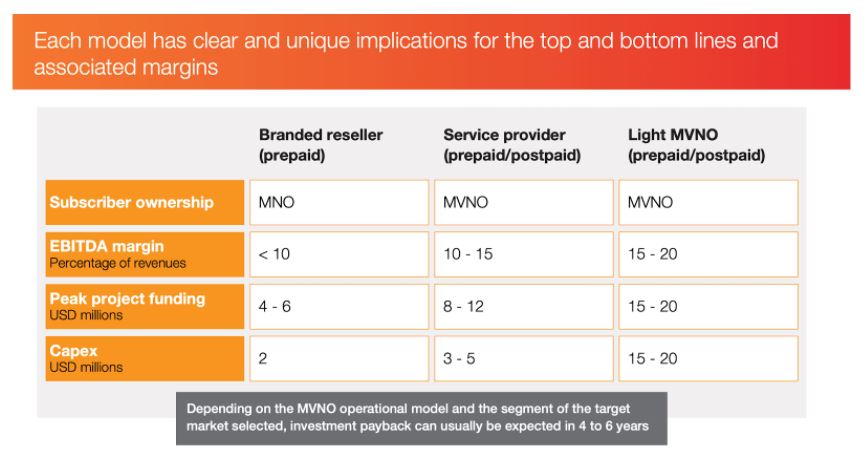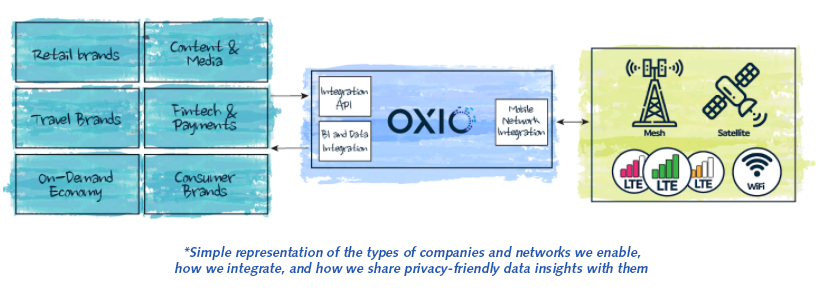While mobile operators have long utilized the partner concept of Mobile Virtual Network Operators (MVNO’s) – allowing asset-light mobile operators to rent their network infrastructure and market plans to consumers – the traditional approach has often fallen short.
At OXIO, we’ve built a platform that allows any brand who wants to package mobile access as part of its customer experience the ability to instantly become a virtual mobile operator with no up-front investments, no individual licenses, and no carrier or telecom expertise. While we strongly believe our approach delivers significant benefits for both carriers and our customers, this article will focus on OXIO’s BrandVNO platform and the benefits it delivers to our carrier partners.
The problems with the traditional MVNO model
There are two primary reasons why the standard MVNO approach has often failed (yes, there are some exceptions) to be a high-growth, high-margin business model:
1. There is almost zero technology differentiation across the MVNO’s
Carriers are often protective of opening up core components of their network (sometimes for good reasons, sometimes not) and the result is that MVNO’s have essentially been given an inflexible black box as their sole integration endpoint. The result of this limitation is that this leaves them with constrained approaches to differentation, such as marketing towards niche demographics or simply lowering prices and margins. Long term, this drives down the prices of the carrier-direct retail plans as well (which is a good thing for us), but it often comes with ugly fine-print caveats such as capped throughput, compressed video, and overall decreased customer satisfaction.
2. The MVNO bears 100% of the costs when it comes to customer acquisition, support, marketing, distribution, and customer retention costs
This leaves MVNO’s with the responsibility of not only operating and supporting an asset-light mobile network, but also building a mobile brand from scratch in an industry often associated with the words “cheap” and “discount.” Even for the mobile brands lucky enough to be backed by Richard Branson, this is an uphill battle, and ultimately, MVNOs are forced to spend most of their gross profit on acquiring new customers while keeping the ones they have (which are mostly month-to-month).
As McKinsey detailed in their MVNO whitepaper, margins for the players are thin yet still require significant operating capital and CapEx relative to profits:

These two market realities combined with other externalities, such as un-friendly or anti-competitive telecommunications legislation and lack of access to network resources (to allow creative offerings for example), fail to provide the incentive for both virtual operators and carriers to continue the status quo of today.
Introducing BrandVNO: How OXIO has improved the traditional approach

We’ve developed our own 100% cloud-based mobile carrier-as-a-service stack within a simplified and modern framework. Using this platform, we’ve improved the standard approach by addressing the most critical issues facing the MVNO & carrier relationship:
Simple, API-based access to core network components and data
Designed with the user in mind, OXIO’s simple API enables customers to easily access and utilize key technologies (such as PCRF configurations, network preference policies, P-Gateway rules, etc.) and business intelligence data, which would otherwise be trapped inside a single carrier network. This increased access and visibility opens up new opportunities by allowing brands and MVNOs to create customized and personalized services, new enterprise offerings, and simply extract more overall data and value from the network.
OXIO also depends heavily on the carriers or MNO’s (Mobile Network Operators) to make it possible to build deep enough into their networks to directly communicate with the necessary individual elements. The good news is that many carriers are seeing the benefit of this approach. In fact when it comes to enterprise value, its likely that a progressive MNO is beginning to see the benefit of exposing their valuable individual assets as plug-and-play elements, as opposed to the traditional, monolithic black box. As Bain and Company point out in their eye-opening article, Telco 2030: Wait-and-See is No Longer an Option:
Large, integrated carriers are sitting on a hugely valuable asset, and separating out part or all of their networks will enable them to raise capital for the investments they need to make in the coming years, such as developing 5G, deploying fiber infrastructure, and building AI capabilities. This also frees the network assets to become new business entities with significant value.
Improved network connectivity across pools of networks
OXIOs patented multi-network technology takes advantage of multiple MNO’s, WiFi aggregation partners, and even satellite-based ISP’s by intelligently switching in a manner that is essentially invisible to the end-user. This delivers a more reliable service and keeps users connected.
As a company currently integrating with MNO’s, we can validate that telling them you plan to partner with their competitors is a bit awkward. However, there are numerous good reasons for carriers to embrace a partner like OXIO who bring this multi-network approach. Some of those reasons are: CBRS rollouts, 5G deployment friendliness, less pressure to deploy low-density infrastructure, and the fact that affordable satellite internet is almost here. So while existing LTE (2G, 3G, and non-VoLTE are rapidly depreciating in many cases) infrastructure deployed in fixed urban and terrestrial environments will long remain dominant and irreplaceable, Bain points out that:
… the changes coming over the next decade are different than those in past eras. The next wave of shifts won’t require new network technologies that take 5 years to develop and 10 years to deploy. Most of the impending changes are software-based and require scale that telcos lack in some parts of their businesses. They will happen in a time frame that will feel almost overnight to a traditional telco. AI and other digital technologies are evolving so rapidly that they will actually force telecom carriers to make strategic choices that will reshape their business models, products and services, and workforces.
Also, when Elon Musk announces his Spacelink Internet service (backed by hundreds of millions of dollars in investment) will cost $99/month with speeds of 50 – 100Mbps, mesh capabilities to avoid unnecessary downlink penalties, and round-trip latencies that many carriers would die for, it would be prudent to think about how to stay one step ahead of the world’s richest man, as opposed to holding onto the old guard.
Also, don’t forget that carriers could be soon competing with current partners such as Jeff Bezos and Microsoft as well.
Simplified, flexible, and affordable network operation
Network operation is too expensive and complex for most brands and developers. OXIO changes that by simplifying the network operation and packaging it into a modern API — think Amazon Web Services for Telco Infrastructure. Look no further than what OTT disruptors such as Uber, Airbnb, and Netflix did with existing legacy assets and business models. The “Uberization of Telecom” has already begun. Through the BrandVNO platform, our MNO partners become the “disruptors” instead of the “disrupted” by making it possible for any brand or developer to deploy their own mobile network with $0 in setup or integration costs.
Summary
Hopefully, this was a helpful introductory overview on not just how we enable our customers to benefit from being a virtual mobile provider, but our commitment to our carrier partners in working with them hand-in-hand to empower “Telco 2030.”
To close out, here are some other ways that our MNO partners are benefitting from our platform:
Market and product expansion — not direct consumer competition –
We are a B2B company only, so we aren’t cannibalizing retail markets with competing offers for the same products. Our model equips brands, enterprises, and MVNO’s with the tools to offer connectivity as a service integrated with their core products and user experiences.
Gain access to untapped markets and revenue opportunities –
We open up the Total Addressable Market (TAM) size by making connectivity simple and cost-effective for people who would otherwise scavenge for WiFi or cannot afford consistently “on” wireless plans. OXIO can connect carriers to different types of consumer segments such as international travelers, low-income subscribers, on-the-go demand economy drivers, and many other underserved market segments … without expensive sales and marketing efforts.
Extract value from underutilized infrastructure –
OXIO offers network partners the ability to offer dynamic pricing (via auctions within our exchange – more on this in a future post!) to customers behind the BrandVNO platform for infrastructure running at low capacity. Similar to how Priceline sells off excess supply of accommodations, OXIO allows carriers to get returns on otherwise unused mobile spectrum and physical infrastructure.
Increase revenues through new products, while delaying retail price erosion –
OXIO is bringing mobile access to more users and giving brands unprecedented ways to connect with consumers while helping carrier partners become more profitable institutions. We’re doing this by paving the way to higher market valuations while providing methodologies to better monetize excess capacity and tap into underserved demographics (again, without cannibalizing high-margin post-paid subscribers).
All in all, the more incentives that shareholders and network operators have to keep investing in their entire network infrastructure stack, the better our future is as citizens of the digital economy. Unbundling mobile network infrastructure just may be the way to get there.
About OXIO
OXIO is the first carrier-as-a-service platform that enables corporations to easily launch and operate their own mobile networks.
We are now commercially offering our technology in Mexico, working with some of the top retailers, fin-techs, on-demand economy providers, and content producers in the country. On the supply side, we are also integrated with (or in the process of integrating) with the top mobile carriers in the region, so that our customers can package a personalized mobile offering into their core user experiences. Through our platform, carriers have a new type of partner in OXIO, allowing them to scale their market share and drive revenue growth without sacrificing margins.
